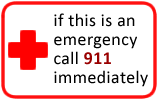Umbilical Cord Symptoms
Umbilical Cord Symptoms
Does this describe your child's symptoms? |
Definition
Symptoms
Omphalitis: Serious Complication
Umbilical Granuloma: Minor Complication
|
When to Call Your Doctor |
Call Your Doctor Now (night or day) If |
|
|
|
Call Your Doctor Within 24 Hours (between 9 am and 4 pm) If |
|
|
|
Call Your Doctor During Weekday Office Hours If |
|
|
|
Parent Care at Home If |
|
|
HOME CARE ADVICE FOR UMBILICAL CORD SYMPTOMS |
Treatment for Normal Umbilical Cord
Alcohol:
Clean the navel with rubbing alcohol 4 times per day.
Use a cotton swab to clean away the dried pus or debris. Be vigorous about it. The umbilical area does not have any sensation, so the alcohol won't sting.
If the cord is still present, clean underneath it by lifting it and bending it to each side.
If the cord has fallen off, pour some alcohol into the depression and remove it after 2 or 3 minutes. (Reason: it takes that long to kill the bacteria.)
There is a minor controversy about using alcohol on the cord. Some hospitals recommend natural drying of the cord because using alcohol can delay separation of the cord by 1 or 2 days. However, alcohol prevents some cord infections and that is what's really important.
Diapers: Keep the umbilical area dry to help healing. To provide air exposure, keep the diaper folded down below the cord area.
Dryness: Avoid tub baths until the area is healed.
Poop on Cord: Getting some poop on the cord or navel is not serious. If it occurs, clean the area with lots of water, followed by rubbing alcohol. That should prevent any infections.
Call Your Doctor If:
Develops a red streak
Fever occurs
Your baby begins to look or act abnormal
Treatment for Superficial Infection of Cord or Navel
Reassurance: A cloudy discharge from the navel is usually a mild infection from normal skin bacteria. Usually home treatment can clear it up quickly.
Alcohol:
Clean the navel with rubbing alcohol 4 times per day.
Use a cotton swab to clean away the dried pus or debris. Be vigorous about it. The umbilical area does not have any sensation, so the alcohol won't sting.
If the cord is still present, clean underneath it by lifting it and bending it to each side.
If the cord has fallen off, pour some alcohol into the depression and remove it after 2 or 3 minutes. (Reason: it takes that long to kill the bacteria.)
Antibiotic Ointment: If a little pus is present, apply an antibiotic ointment such as Polysporin 4 times per day after each cleansing (no prescription needed).
Diapers: Keep the umbilical area dry to help healing. To provide air exposure, keep the diaper folded down below the cord area.
Dryness: Avoid tub baths until the area is healed.
Call Your Doctor If:
Develops a red streak
Fever occurs
Navel is not completely dry and clean after 3 days using this treatment
Your baby begins to look or act abnormal
Treatment for Normal Umbilical Bleeding
Reassurance: A few drops of blood is normal with cord separation. Friction against the diaper may make it recur.
Bleeding: Apply direct pressure for 10 minutes with a sterile gauze to stop any bleeding. Clean the area beforehand, rather than afterwards. (Reason: to prevent rebleeding)
Diaper: Prevent friction on the umbilical stump from the diaper by folding it down or cutting a wedge out of the diaper.
Call Your Doctor If:
Bleeding becomes worse
Few drops of blood continues over 3 days
Your baby begins to look or act abnormal
Treatment for Normal Early Separation of the Cord Before 10 Days
Reassurance: The cord can't fall off too early. The average cord falls off between 10 and 14 days.
Alcohol:
Clean the navel with rubbing alcohol and a cotton swab 4 times per day.
Pour some alcohol into the depression and remove it after 2 or 3 minutes. (Reason: It takes that long to kill the bacteria.)
The umbilical area does not have any sensation, so the alcohol won't sting.
Diapers: Keep the umbilical area dry to help healing. To provide air exposure, keep the diaper folded down below the navel.
Dryness: Avoid tub baths until the area is healed.
Call Your Doctor If:
Develops a red streak
Fever occurs
Your baby begins to look or act abnormal
Treatment for Normal Delayed Separation of the Cord Beyond 2 Weeks
Reassurance: Most cords fall off between 10 and 14 days. All cords eventually fall off by themselves. Continue to be patient.
Stop Alcohol: Stop applying rubbing alcohol to the cord. Rubbing alcohol sometimes also kills the good bacteria that help the cord dry up and fall off.
Diaper: Help the cord dry up faster by keeping the diaper folded below it. Another approach is to cut out a wedge of the diaper (if disposable) with scissors so the cord is exposed to the air.
Call Your Doctor If:
Cord begins to look infected
Fever occurs
Cord is still attached over 6 weeks
Your baby begins to look sick or act abnormal
And remember, contact your doctor if your child develops any of the "Call Your Doctor" symptoms.
Updated:
March 22, 2017



